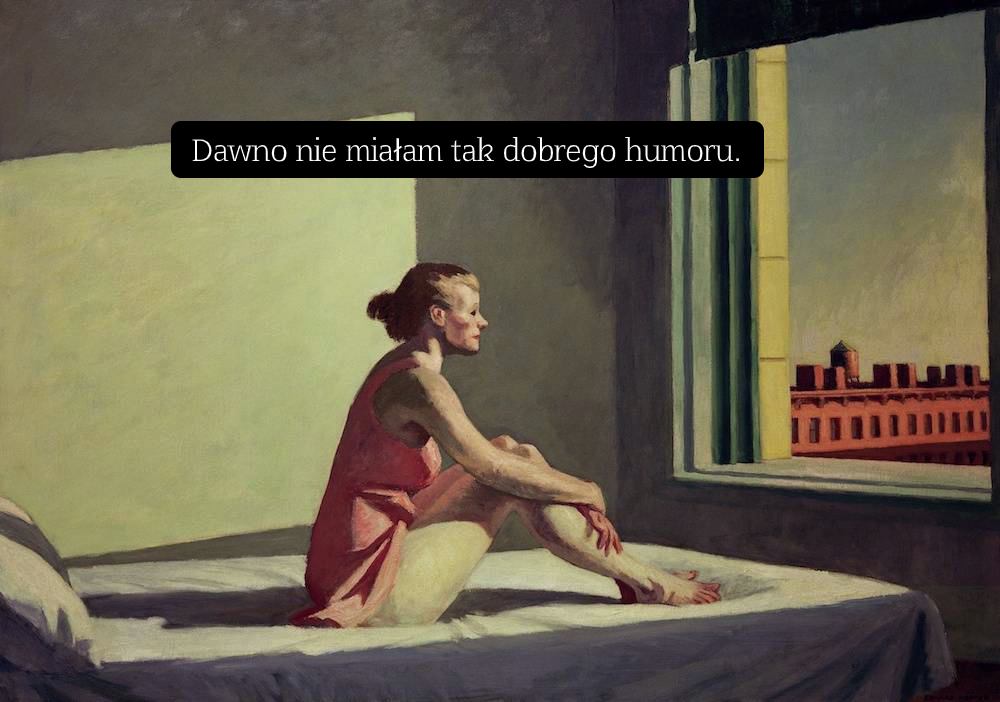Sztuczne Fiołki, FB, Hopper, 21.03.
25 February 2020, Tuesday, 4 °C, rain
As every week, we went to the Pan Garpub with Staś in the evening.
It’s a magical place on Słowackiego Street, where we listen to jam sessions, go to concerts and eat Georgian pies. The place looks a bit like a post-communist pub in the Czech Republic, and a bit like a frame from the Twin Peaks series.
We meet with family, friends and colleagues from work there. We are friends with the owners of the pub – Georgian Gia and Polish Szymon.
However, I felt surrounded by too many representatives of my family, colleagues and, finally, even students. We sat, as usual, crowded, trying to shout over the musicians playing. And our imaginations were fuelled by a new virus that has come from China to Europe, and has already appeared in Italy (about 300 cases), France and Austria.
Everyone was talking about the virus, telling more or less likely stories. In fact, no one knows if it’s better to be afraid or laugh or, rather, fantasise. So, various conspiracy theories have also appeared, for example, that it is America’s biological weapon against China.
We also talked a lot about travels, although it is not known whether or not the plague will thwart the travel plans of all of us. Together, we want to meet first at the festival in Ostoya on the Brda in June, and then at the Pol’And’Rock festival in Kostrzyń on the Oder.
27 February 2020, Thursday, 5 °C, sun and heavy rain
In Europe, the virus has already arrived in Italy, Germany, France, Great Britain, Spain, Austria, Switzerland, Greece, Denmark, Estonia and Georgia, among others. Every now and then in Poland there are reports of suspicions and people quarantined. However, the diagnoses do not confirm infections.
Precautionary measures have been taken at our university. Hand dryers have been turned off because they are said to transmit the virus the most. Hand washing instructions hang everywhere.
I gave a lecture about Malevich’s Black Square in the context of Matyushin’s opera Victory Over the Sun, for which Malevich prepared the set and costumes. I told students about the depressing message of this futuristic work presenting a vision of the world after a disaster. On the one hand, it is a victory over the past and the rules of the old world, and also praise for technology. On the other hand, it shows a future where there is no happiness, but everyone feels happy and immortal. There is no sun, no memories or memory in this world.1
This depressing vision has reminded me of the recently read book Fahrenheit 451 by Ray Bradbury, in which, together with forbidden books, the memory of the past, philosophy and human dramas was rejected. And although there was no happiness there, everyone felt happy, stuck in front of the ‘family’ projections. Certainly it is an allegory of stupid television programmes, but disturbingly it also has something to do with Facebook, although Bradbury wrote his novel in 1953.
It is known, however, that visions of futurists sometimes come true. Lem came up with an electronic book reader.
I asked my son Joszko, who is studying philosophy, how he has understood this family on TV in Bradbury’s novel.
‘Is it important? You can insert television there, you can insert the internet. You can insert whatever. Whatever you want,’ he replied, bored as usual.
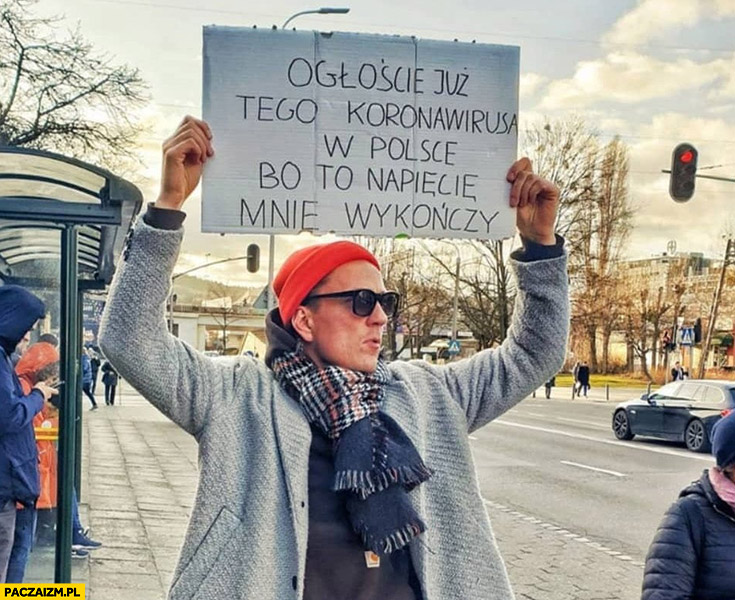
29 February 2020, Saturday, an extra day in the leap year, 2 °C, sun
We went with Oskar and Wera (my second son and his girlfriend) to the ski resort Czarna Góra in Sienna.
Almost all the way we exchanged news about the virus, because it is spreading more and more across Europe. On this day, the number of infections in Italy would exceed 1,000, but we did not know that yet.
In fact, however, it is still not much compared to around 80,000 in China.
We’ll probably be able to control it and certainly the epidemic will not spread as much as in China, because we do not have such population density here.
Wera said that, at her dad’s, she had listened to an account of a Polish woman living in Italy in the quarantine region.
‘There is a drama. Only one person can enter a store. Besides, they don’t even deliver food there, everything is closed. I tell you, a drama!’
We were also thinking about when the virus would appear in Poland. We laughed at a photo that was circulating on the internet recently. The man is holding a poster saying: ‘Announce this coronavirus in Poland at last because this tension will kill me.’
It reflects our state of mind well because we know that the virus will come to us, but we do not know when. We feel that it is fast approaching.
1 March 2020, Sunday, 5 °C, rainy
My legs hurt after skiing. Piotr and young Hanka came to us. She is panicking terribly as if something terrible is approaching us. In any case, we have to postpone our joint trip to Iceland because the virus has even appeared there.
In the evening we went to Centrum Kultury Zamek (Castle Cultural Centre) for a farewell concert by Lao Che. The guys from the band seemed to have a terrible hangover, but they played beautifully. There was a good energy between them. Someone in the audience wondered if they would play Zombie, but they didn’t.
Weronika sent hearts to Mariusz, who was making funny faces.
At the end many people were crying. Even Joszko, who did not want to stand with us under the stage (I think he thinks we are embarrassing), said that he also cried.
It is a real regret that Lao Che is finishing this project. They have wise and thoughtful lyrics. They are attentive and do not remain indifferent to what is happening around them.
4 March 2020,Wednesday, 7 °C, torrential rain and windy
I go to the university early in the morning and, when I enter the rector’s office, the ladies immediately tell me the news that the coronavirus is already in Poland!
Anyway, I could deduce this from a conversation between Karolina Piotrowska and Michał Figurski on Antyradio, which I listened to in the car. But they are always fooling around, so I wasn’t sure they were serious about it. The first case of the new virus appeared in Zielona Góra. The coronavirus was brought from Germany by one of the poviat residents returning by coach from the carnival in North Rhine-Westphalia. The man is being hospitalised although he feels fine.
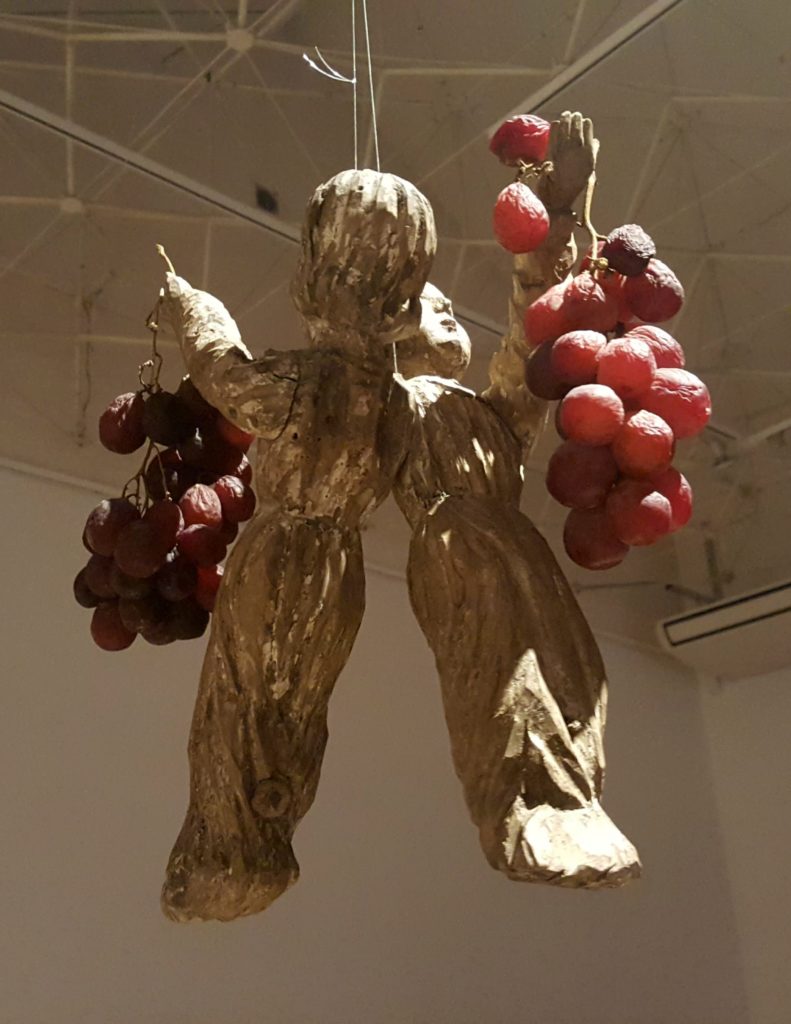
7 March 2020, Saturday, 7 °C, cloudy, drizzle, rain
I think I’m paranoid because I’m convinced that everything that is planned in the near future (for example, going to the cinema, restaurant, gallery) must be done this weekend, possibly in the coming days because in a week or two it will be too late.
It’s good that we saw the Oscar-winning Korean film Parasite. Then we talked about it for a long time with Staszek, especially about comparisons with Joker. Both these decadent films show that the world of social divisions has already reached its maximum. And then there can only be a disaster.
In connection with my paranoia, we went to an Italian restaurant for lunch and to the Arsenał Gallery for the exhibition Catering for the Longest-staying Guests in the Gallery by Leszek Golec and Tatiana Czekalska.
All the works come from recycling. Liturgical items, pieces of church equipment, icons and sacred books bought at flea markets and antique shops, gain new life here. Artists do not contribute to environmental pollution and use these unusual objects to create surprising compositions. They strengthen the aesthetic message with the play of light and shadow.
The catering itself is essential, not for us, but for the inhuman others, the smallest and often invisible: moths, fruit flies, common furniture beetles and other insects, which can be moved to a safe place thanks to the avatars in the gallery. They live in these objects, and some of them, like common furniture beetles or moths, are even co-authors of these works.
In this way, the artists show the circle of life and death, at the same time pointing to nature’s power of survival.
10 March 2020, Tuesday, 10 °C, sun and wind
This is only the sixth day of the virus in our country. The number of infected people, according to official data, is 22. Poznań has been petrified by the news that one of these cases (a severe one) has also appeared here.
There are already over 10,000 infections in Italy, and around 1,500 in Germany, over 113,000 worldwide.
I went to the store to replenish my supplies. I bought a few small things and a bottle of wine. People had baskets stuffed as if they were preparing for war.
Classes were cancelled at schools in Poznań. Yesterday I bet with Joszek that schools and universities would be closed in our city within a week. He tapped his forehead and said it was impossible.
It turned out today that I won the bet. At 5 p.m. the situation at his university was also clarified. Although they have created a fan page saying that they welcome the virus to lectures, tomorrow classes have been cancelled.
We decided to celebrate my winning bet and go out for a Georgian pie in the evening and, at the same time, see what life is beginning to look like during the epidemic.
At Pan Gar, we hugged Szymon. Filip was worried that he would not defend his bachelor’s degree because the libraries would be closed. Rafał complained that the university remained tight-lipped and did not cancel classes. Hanka said that when she was coming back from classes today, she had the impression that she had some hallucinations. People carrying large shopping bags were still passing her.
Joszko, who had said a few days earlier that he had not wanted to talk about the virus at all, showed us an interactive map of its spread.2
‘It’s fascinating,’ he said.
I know this because I discovered it a few days earlier. However, it was new for Staś.
Then Joszko went to the city to celebrate the cancelled classes.
11 February 2020, Wednesday, 9 °C, sun and clouds, strong wind
A phone call from the rector’s office woke me up, inviting me for a crisis meeting at 2 p.m. It has been exactly a week since the announcement of patient zero from near Zielona Góra. Today, 25 infections with the virus have been confirmed in Poland.
The government has decided to close all nurseries, kindergartens, schools and colleges nationwide for two weeks. Theatres, operas and cinemas will also be closed by government decree. All municipal institutions are closed in Poznań. It’s good that Stanisław and I went to the gallery for the exhibition last Saturday! It looks like it wasn’t paranoia.
Unfortunately, our contemporary art workshops for secondary school youths at the Dom Tramwajarza centre cannot continue. We had a wonderful group of secondary school students who made coronavirus posters at the last workshop on visual communication.
14.00 – a crisis meeting. Just because classes have been cancelled doesn’t mean that we’re not working. We are turning to e-learning. After a stormy debate with an IT specialist, I come to the conclusion that there will be more work than if we run classes normally. Shit! We need to make this clear to employees now.
The WHO has announced a pandemic today.
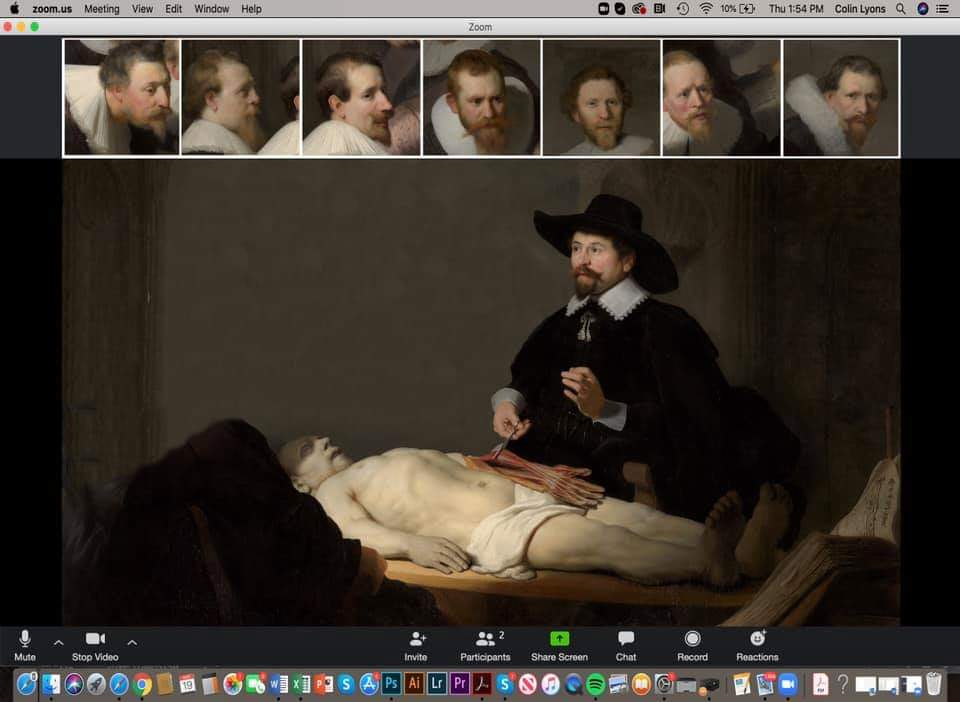
12 March 2020, Thursday, temp. 13 °C, sunny and very windy, sometimes it rains
I went to the university because I forgot to hand over documents related to my business trip to Warsaw yesterday.
On TOK FM radio, I listened to Professor Przemysław Czapliński talking about books concerning epidemics. He said that this topic never concerns the epidemic itself, but social relations, human behaviour and relationships; hidden fears and prejudices, the ability to behave in unforeseen situations.
The buildings of our university are closed, dark, everything looks extinct. The gentleman from the library was talking to me through the glass door. Accounting ladies looked at me suspiciously that I came to them at all.
As Weronika again sent me photos of empty store shelves, I decided to check the situation in the Piotr and Paweł store on my way back. In fact, there were many empty shelves, including, unfortunately, those with vegetables, and I wanted to buy them. I bought grapefruit, oranges, Chinese sauces and Italian pasta.
When I drove to the parking lot, I noticed two graphics on a post. I looked at them and thought that someone would probably come soon to get them.
When I was shopping, it started to rain heavily and, when I left, I saw that one of the graphics, unfortunately, had begun to melt away. So I threw them into the trunk to save them. One of the graphics is entitled ‘Babylon’ and shows two human faces surrounded by Venetian-style architecture. Is this a sign?
At the end of the day, I have added a profile overlay #stayhome #readbooks on Facebook.
And what else can I do?
However, I have recently been reading less. I still can’t finish Dehnel’s book Ale z naszymi umarłymi [But with Our Dead] about Polish zombies (Przemo Czapliński also mentioned it on TOK FM radio).
Fortunately, I have already finished ‘Purity’ by Franzen from during that strange time when I was compulsively reading. Since the beginning of the year, I have probably read five of Murakami’s books, the excellent ‘Middlesex’ by Eugenides, ‘House of Day, House of Night’ by Tokarczuk, a quite poor first ‘Metro’, and the interesting ‘Welcome to Russia’ by Glukhovsky, and the catastrophic SF novel by Ray Bradbury.
I read as if the world was about to end… I read everywhere, at home, in the car (of course only when I was a passenger) and even at the gym.
I was just reading faster and more, although I delayed reading Tokarczuk so I could enjoy her narrative.
I haven’t had time for anything for a few days, especially for reading…
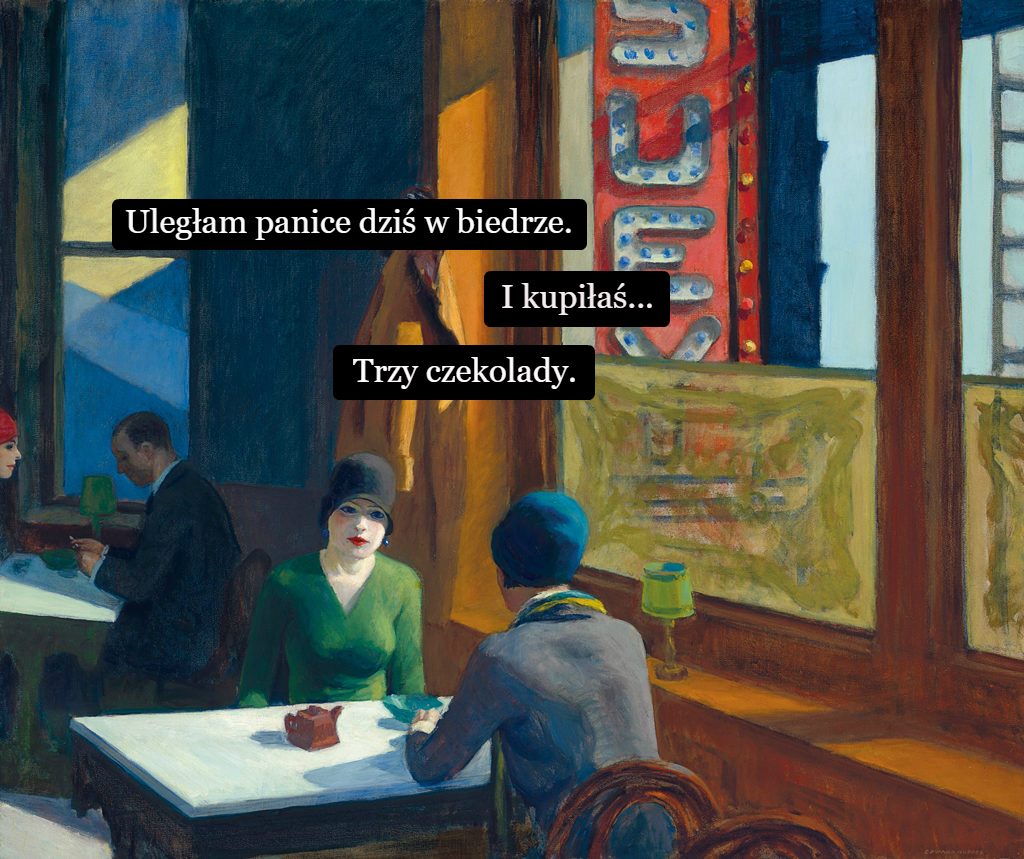
13 March 2019, Friday (Friday the 13th), 9 °C, the sun was shining in the morning, then a very gusty wind began and it started to rain
Weronika has sent me a report from the pharmacy: ‘I was in the pharmacy today, a drama. And the queues. There was neither vitamin C nor aspirin nor even gloves. And many people, the pharmacists, were wearing masks. A picture like from China. You must write about it.’
But are you sure it is a picture like from China?
My artist friends are fascinated by the recording from Wuhan, showing how people open windows at night and scream. Young, old, children. They scream to cheer each other up, but you can also hear the despair.
As a friend of mine, an artist, told me, although it is scary, it is also fascinating in audial terms. Another artist, the young Hanka, added that it looked like a finished artistic work…
The vision that we would also be sitting in our homes, basically without leaving them, is terrifying.
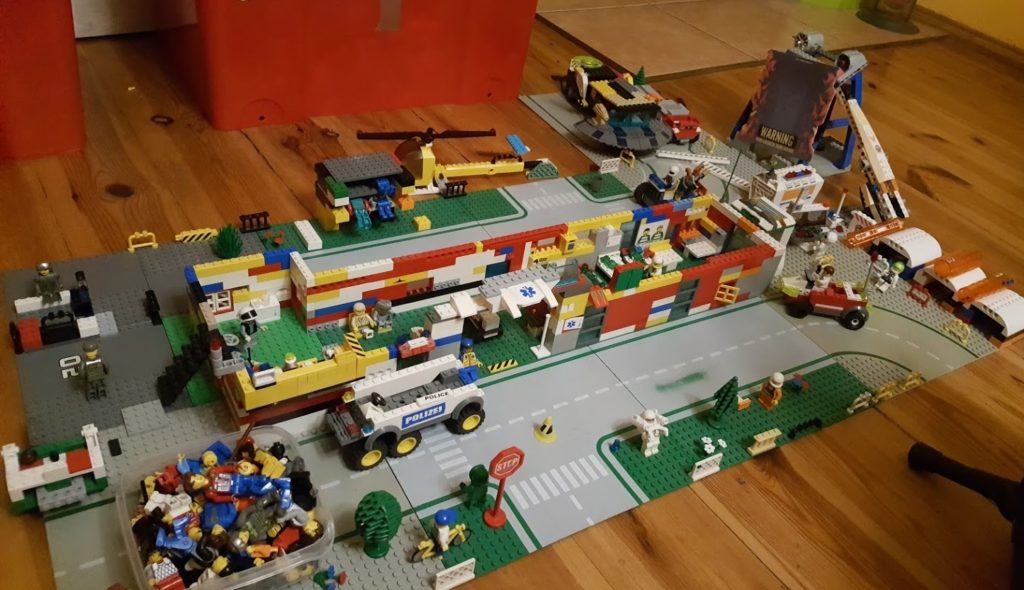
15 March 2020, Sunday, 8 °C, sunny, quite strong wind
Already 112 infected in the country.
In Italy: 21,729; in Spain: 6,391; in Germany: 4,649; in Portugal: 240; in the Czech Republic: 231.
The virus has reached Mongolia, Uzbekistan, Togo, Rwanda, Gabon and Ethiopia. It’s almost everywhere…
After dinner, Wera and Oskar, who loves LEGO bricks and still buys some sets, came by. We decided to vacuum the old bricks. We have built an infectious hospital and accompanying field ward, as well as a portable laboratory. It is surrounded by streets with ambulances and police. There is a helipad. There are: an ambulance entrance, an emergency room, a laboratory department and patient rooms in the hospital. We have put green men there – our reptilians (because Staś says it’s all their fault).
After showing photos from his family’s WhatsApp, Marek, a fan of black humour, asked about the morgue, so Oskar built it. Witek, Staś’s brother, was indignant that he did not have the equipment of the Great Orchestra of Christmas Charity (WOŚP), so I placed old telephone cards with WOŚP’s hearts in the hospital, which were occasionally issued on the occasion of the early Przystanek Woodstock festivals. Today we found a collection of these cards in the chest with the LEGO bricks.
Jerzy Owsiak organises these festivals to thank volunteers for their work at WOŚP. That’s why they are free. He not only invites great bands, but also fantastic people who say wise things in the Academy of Fine Arts’ tent.
A year ago I cried when I saw crowds of people not only in the ASP tent, but also around the field in front of it, who listened to the difficult discussion about anti-violence issues.
Last year there was also Olga Tokarczuk, who, as always, said only wise things about the need for community, mindfulness and the need to care about animal rights.
Together with several people from our faculty and students who helped us, we organised artistic workshops as part of the Academy of Fine Arts for two years. It’s a fantastic adventure and the participants are very interested in art and open to discussion. They also do interesting artworks. Some of them have been put up for the WOŚP auction this year.
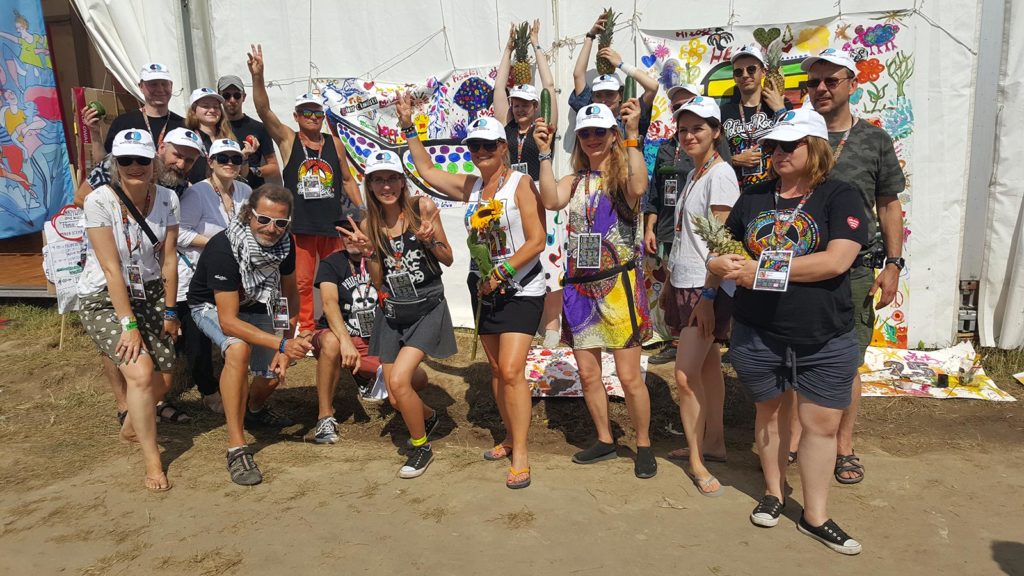
Today, when respirators are so badly needed, it is worth remembering that many of them have been bought thanks to the WOŚP fundraising, just like the majority of medical equipment.
Returning to our construction of blocks and art. Looking at this strange hospital with field tents, a laboratory, staff in overalls and even a morgue, I am wondering about the inadequacy of our hospital and the resemblance to Zbyszek Libera’s LEGO Concentration Camp Set.
The situation is a bit like in the video by the Azorro group, which shows a typical Polish family: mum, dad, daughter and son (Rodzina, 2004).3
However, their conversations are not typical because they relate entirely to contemporary art, and the activities of children are similarly unusual: this drawing of a black square on a white background, arranging a pyramid of animals, there is also a proposal to build a concentration camp from LEGO blocks.
Our conversations were also unusual because Oskar, an admirer of not only philosophy but also of history, told us about a famous pestilence: about the black death in fourteenth-century Europe and the plague epidemic in Poznań in 1709, when 9,000 of the city’s 12,000 residents died of the disease and hunger. The corpses were buried in the place where the Kupiec Poznański store is today.
Returning to artistic associations, it is difficult to say whether art (fantasy) is ahead of reality or vice versa. To what extent does the epidemic actually exceed that which we know from books and films in terms of the scale and strangeness of the situation in which we have found ourselves?
Does the unpredictability and volatility associated with it make us feel as if we were all in a film or dream, as Weronika said?
Later, I have discovered that a group had been created on FB in which pandemic dreams are told, well-known Polish writers and critics participate in it (I have joined the group, but I don’t follow the posts because I am too scared by my own dreams).
‘Usually it is mass culture that takes care of certain fears, problems and extremes, finding their symbolic reflections. Meanwhile, the reverse process is taking place before our eyes: It is reality that takes the form of a fantasy that has been brought to life by mass culture,’4 says the old professor of anthropology in Dehnel’s book about zombies.
This is why Przemo Czapliński said on TOK FM radio that the book Ale z naszymi umarłymi is basically about what is happening now.
Three days ago, Antyradio reported that the virus appeared in Kentucky’s Harrison Memorial Hospital.5 And it was in this hospital that Rick Grimes, the hero of The Walking Dead, woke up to discover that the world is being digested by a zombie pandemic.
The creator of the series, Robert Kirkman, confirmed some time ago what caused the apocalypse and it was not COVID-19.
Also, Stephen King strongly disagrees with the theory that he described the coronavirus in his legendary Bastion of 1978.
20 March 2020, Friday, 12 °C, cloudy
I am beginning to be afraid of checking these data: Poland: 367 infections; Italy: 41,035; Spain: 18,077; Germany: 16,290; France: 10,891; Czech Republic: 694. The number of all registered infections worldwide: 246,275.
The first answers to yesterday’s e-learning task are flowing in. In the context of Elvin Flamingo’s work, The Symbiosity of Creation, I asked about the possibility of imagining the world after a disaster.
One student draws attention to the issue of symbiosis of various creatures living on earth and the need for mutual cooperation. I reply to her that in this human-inhuman symbiosis we are not positive actors at all, we have brought this world to the edge of the abyss.
I think that, paradoxically, the virus can be one of the forms of protecting the world against us as a species.
Significantly reduced emissions of nitrogen dioxide, improvement in air and water quality, reduction of the carbon footprint, return of wild animals to cities – all this has been happening very quickly after the outbreak of the epidemic.
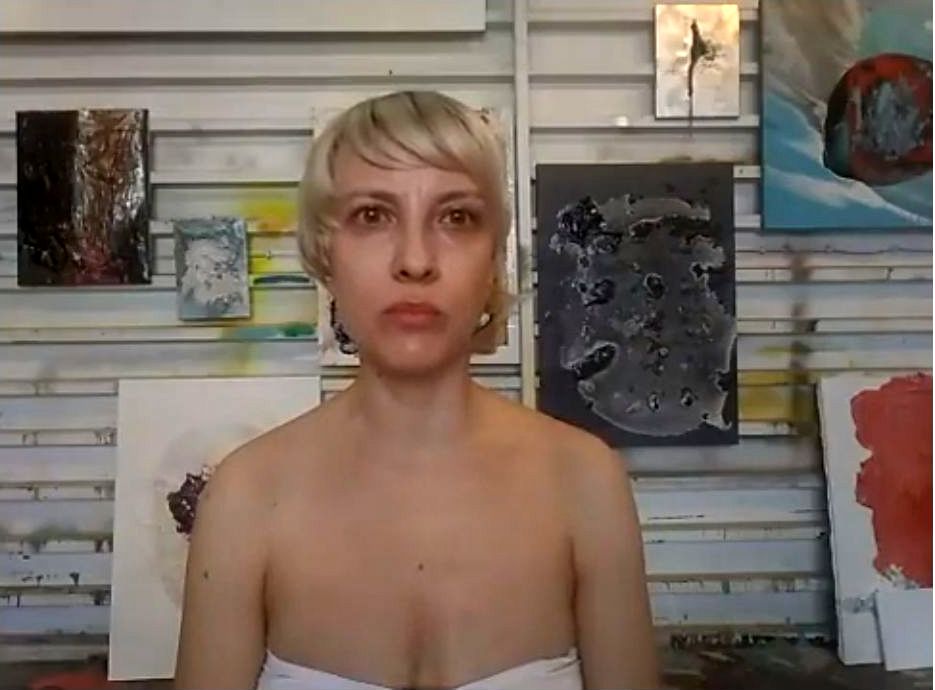
31 March 2020, Tuesday, 3 °C, sun, clouds, sometimes snowing
The plague is galloping further: USA: almost 166,000; Italy: almost 102,000; Spain: almost 95,000; Germany: 68,000; Portugal: almost 7,500; Czech Republic: 3,000; Poland: 2,215.
The number of all infections in the world is almost 810,000.
I spent the whole day on e-learning, checking master’s theses, creating reports on distance learning.
Students approached the matter very responsibly. They are working, finishing their master’s theses and also sending very clever answers to successive tasks.
I have solved a lecture on contemporary art by sending them my texts and related presentations. One student wrote: ‘I personally like reading these texts because they are simply interesting and I can focus more on a given topic by analysing it myself.’
But, in general, this work requires more time. Actually, we all have the impression that time has accelerated and is rushing by like crazy.
As one of our female artist professors put it: ’Do you also have the impression that time is running even faster and more intensely than before the coronavirus? … as in some virtual lens…’
I am watching Iza Chamczyk’s performance of Codzienność w koronie [Daily Life in the Times of Corona] organised by the Entropia Gallery in Wrocław as part of the Entropia at Home project. The artist presents everyday activities such as painting, drinking water, eating food and smoking a cigarette. This is accompanied by messages read in the background about what should be done during the epidemic and what should not (often contradictory). In the background you can also hear the ticking of the clock and the sound of the game show indicating the wrong answer. Iza performs her actions faster and faster, and the situation becomes more and more nervous.
We have been forced to sit at home in a very short time, we are bombarded with hundreds of pieces of official, unofficial, as well as fake, news, advice, orders and prohibitions telling us how to behave, what to do and what not to do.
Sometimes I get crazy, and Iza’s performance makes us realise that we are all in a similar situation of uncertainty.
Not only the rapid growth of infections around the world, but also the uncertainty of the situation and the dynamics of change make everyone concerned.
Until recently, something was possible that today does not fit into our pandemic imaginarium. A month ago I was skiing; at the beginning of March – in the Arsenał Gallery and at the restaurant. On 10 March, I saw my friends in our favourite Georgian pub. Schools and colleges have been closed for three weeks. However, the time ‘before’ seems very distant.
3 April 2020, Friday, 10 °C, sun and clouds
I had a crisis last night. I was reading the works of students and began to cry. They give very thoughtful, wise statements. I am surprised by how mature these texts are. I really miss conversations with them (the group has over 60 people so conversations would be difficult on the on-line platform).
I wrote to one student to ask her to call me because I felt it was hard for her. She called today and we talked. She told me that she was so happy to study. She is only in her first year of her MA studies, previously she studied something else. She enjoyed the classes very much and now she is sad that she cannot go to the university.
I also got some nice emails from students. One of my favourite students writes: ‘You do very important things, this difficult time shows it especially clearly. Your lectures, texts, personality, the way you contact us are support for us, and just help us. We are living in a time that, like a mirror, shows us what we really are, but in revealing our weakness, it also shows strength. I have learned a lot, and thanks to you, from the first lectures on the Theory of Art to this day, I understand the world around me and myself better and better.’
You get better immediately!
I decide that I will change the form of e-learning and write texts for them on the blog, linking the works discussed. I want the form of these texts to be more personal.
I want to reactivate the ‘Straszna Sztuka’ [Terrible Art] blog, which used to be quite popular, but the platform I used was liquidated, and I hadn’t managed to move it elsewhere before that happened. And so, the blog was lost.
Now Oskar, my son, an IT specialist, has set up a professional blog for me and bought his own domain. I don’t find editing easy. It drives me crazy!
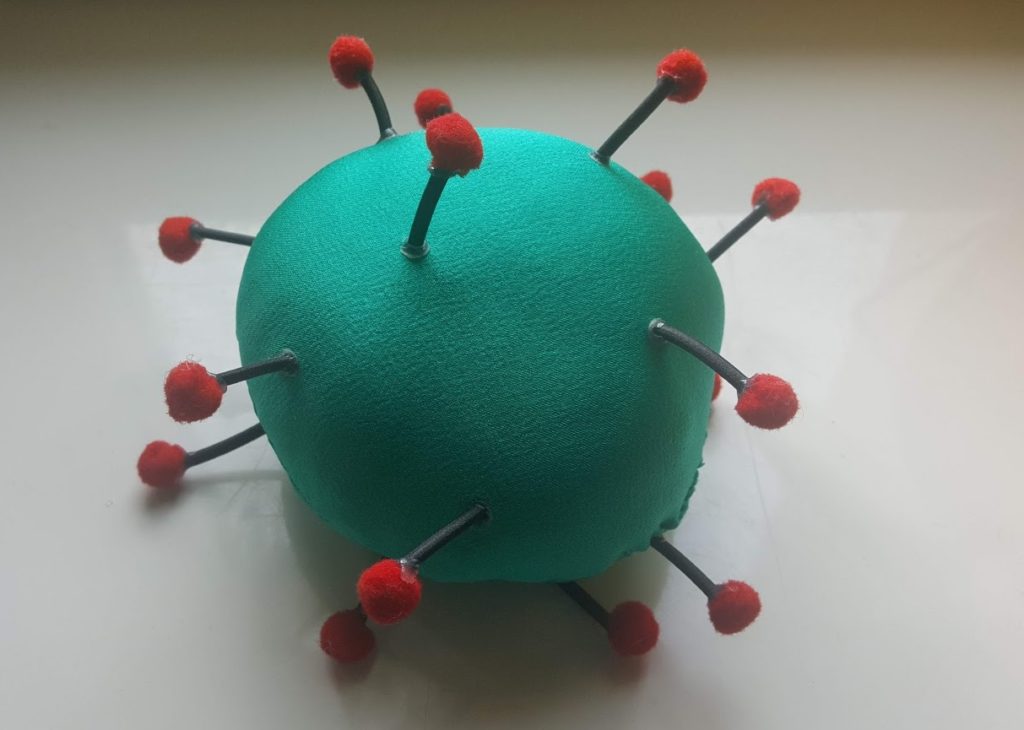
4 April 2020, Saturday, 12 °C, sun
Oskar showed me how to edit the blog. All in all, it’s quite a simple matter. The subpages look better and better.
In the evening I found the archives of my old blog on the internet. I was so happy! Therefore, I will be able to transfer some entries to the archives.
You will not believe, my first entry I came across was from 22 August 2006 and concerned viruses, specifically toy mascots in the form of viruses, which I bought in Bakcyl’s stall during Survival – A Review of Young Art in Extreme Conditions, which took place at the railway station in Wrocław.
In this entry I wrote:
‘Girls from the Bakcyl Bakcyl group: Michalina Kostecka and Maria Kiniorska decided to show the absurdity of media panics about diseases. Diseases and epidemics are the breeding ground for the media, are unreal and can be easily assimilated or consumed. In consumer culture, everything is for sale! Even a disease and the panic that arises around it.’
I don’t know what this ‘unreal’ may have meant. Although I sometimes feel like I am in a film or a dream now.
5 April 2020, Sunday, 13 °C, sun
In Poland, more than 4,100 are infected.
A beautiful Sunday spent nicely at the allotment. We planted pansies. Idyllic, calm, nice. Only the birds sang and Staś said that they made a lot of noise. People did not appear in the area at all. For a moment I had the impression that we were the only people on earth saved from a disaster. The world narrowed to the five of us, strangely. Let it not last too long because you also need to see other people.
Along the way – parking lots and paths to the beach closed with tapes. Empty, only police patrols.
I have read in one newspaper that after this epidemic we will all suffer – not from coronavirus, but from depression, alcoholism, rickets and obesity.
Closing green areas seems to be an exaggeration. Parks and forests were not closed even in Germany.
The strangest news from Antyradio:
In China, a pig with an elephant’s trunk was born.
The streets of the Welsh town of Llandudno were infested with satanic goats. These ‘horned devil broods’ eat flowers, nibble on hedges, spread confusion and destruction.6
A 15-year-old was stopped by the police yesterday for moving around without adults. It turned out that grandma sent him to the store for marjoram because she needed it for a dinner cooked. The family court will decide whether to punish the teenager with a fine.
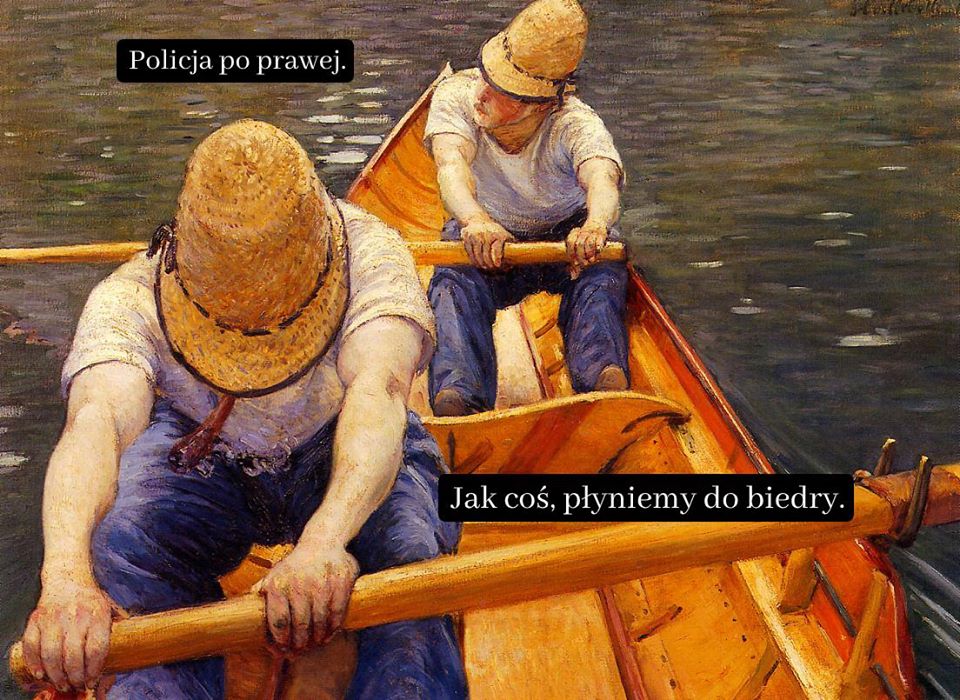
6 April 2020, Monday, 19 °C, sun
The number of infections in Poland has risen to over 4,400.
The worst situation is in the United States – over 337,000, in Spain over 135,000. The number of infections in Italy is not growing so fast – there are currently almost 129,000. There are also over 100,000 cases in Germany. In France – nearly 94,000. In the Czech Republic – nearly 4,600.
The plague is already in 183 countries, including Belize, Papua New Guinea, South Sudan and Gambia.
There are absurd reports of fines from all over the country. In Olsztyn, men got fined for washing a car in a self-service car wash. In Katowice, a man was fined for taking a walk with a child.
The police did not allow anyone to go to the coastal beaches, any other beaches or, of course, to the forests.
There is a murderous tendency in this eagerness to punish citizens. Parents of young children living in blocks of flats are in the worst situation. How can they explain to them that they can’t go out to the playground, play with friends or even go for a walk? Who will go crazy first – children or their parents?
There was a flood of quarantine memes on the internet. Their authors are particularly keen on using art. One of the artists, Jarek Kubicki, dealing with rather kitschy work, used the paintings of Monet, Gierymski and Hopper and into them he inserted figures of policemen giving out fines.
He named his series 32nd Day of Quarantine. Now he sells them as unique graphics. You have to manage somehow and I’m not ironic here because the situation for creators is really difficult.
As for Hopper – he is invoked as a painter who often depicted his characters in isolation, locked in the house or looking nostalgically out of the window (one of the most famous canvases, of course, depicts his wife Josephine and can be treated as a quarantine icon).
The FB fanpage ‘Sztuczne Fiołki’ [Artificial Violets] also came to life with their valuable comments on the reproductions of artworks. In this case, various images from ancient and modern art are used, to which comic speech bubbles are added and text appears on a black background, which most often absurdly relate to current events and are written in a contemporary, common language.
One of my favourite violets presents a picture by Gustave Caillebotte showing the oarsmen who exchange information: ‘Police on the right’, ‘If they ask, we’re sailing to the Biedra store.’ On the other hand, The Expulsion of Adam and Eve from Paradise by Daniel Vertangen has been marked with the text ‘Get out of the forest’.
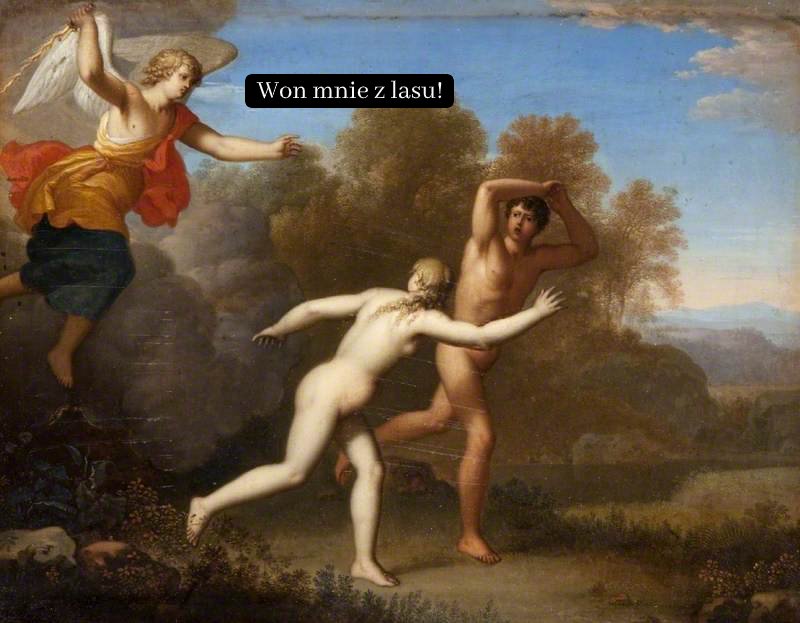
8 April 2020, Wednesday, 18 °C, sun
In Poland, there more than 5,000 infections, worldwide the number of infections is approaching 1,000,500.
Paulina Wycichowska has come up with an interesting idea and persuaded her friends, choreographers and dancers to create a joint Quarandance, which on the one hand is to promote the #stayathome action and, on the other hand, to give comfort and enable people to connect. Over 157 people took part in it. The music for the project has been created by Michał Strugarek, and it has all been perfectly edited by Agnieszka Jankowiak and Amelia Zabel.
The dancers have decided to reveal their privacy, show fragments of apartments, made and unmade beds, and accompanying children and animals. The cramped flats, unusual conditions and especially the bizarre dancing attributes, such as one’s private bed or sofa are amusing. The few lucky ones can dance in an open space, even in their own gardens or terraces. Some emphasise the absurdity of the current situation in their choreographies. The project shows that you can create something together, dance together, although you remain alone. It also makes us realise how much we need culture in its various forms in these difficult times. Especially one that offers us a dose of positive energy. Art can act as a kind of therapy.
9 April 2020, Thursday, 17 °C, sun
Number of infections: over 432,000 in the US, over 152,000 in Spain, nearly 140,000 in Italy, over 113,000 in Germany, over 83,000 in France and around 61,000 in Great Britain. In Poland – 5,341, in the Czech Republic – 5,335. Worldwide, over 1.5 million. I still can’t get over how fast the infection is growing around the world.
Easter is coming, Stasiu is baking bread, and we don’t care too much about the housekeeping. We have a few days off, today I have a lecture.
A familiar lecturer has published an entry on Facebook: ‘Under this post, more lecturers admit that they habitually did classes. More interestingly, students apparently participated in them. This is probably the first time in the history of Polish higher education that everyone wants to work like that.’
10 April 2020, Good Friday, 16 °C, sun and clouds
In Warsaw, the anniversary of the Smolensk catastrophe was commemorated, but people did not keep a distance from each other. The police did not intervene.
A shock and disbelief! How does this relate to all these restrictions and fines? I can only imagine how those who were fined for running in the woods, going for a walk with a child, washing a car in a car wash and even changing tyres feel. A friend writes that there could only be five people at her father’s funeral.
My friend, a philosopher and also our lecturer, Roman Kubicki, says in an interview: ‘I don’t know if we’re sailing on the Titanic, or maybe we’re flying by Tupolev, and it may well turn out that we will get out of it battered, but in one piece. I believe that this will be the case. Life has always been stronger than death.’7
Yes! And this life force must be cultivated.

15 April 2020, Wednesday, 12 °C, sun and wind
I did not think that I would live in times in which, in addition to a pandemic, an attempt will be made to introduce draconian laws limiting human rights and introducing ideas as in primeval times.
I did not think that I would live in such interesting times that the seemingly boring social quarantine would abound in such extreme events as going to the forest or to the cemetery (I also wanted to visit my mother!) as part of civil disobedience, or queuing at a pharmacy in the middle of the city for over an hour as part of the Women’s Strike.
In no scenarios before the epidemic would we have foreseen what is happening now in Poland, and Atwood’s The Handmaid’s Tale seemed a distant metaphor.
Meanwhile, today the strangest and at the same time most horrible bills were read in Parliament: on allowing children to participate in hunting, on returning Jewish property, on prohibiting sex education and on protecting conceived life.
I tried to listen to these discussions. The only thing that saved me was the fact that I was smoking and I had to leave the computer and take a break several times.
During Godek’s speech, I decided that I had to turn it off, otherwise I would go crazy, and I went to the pharmacy on Święty Marcin Street to buy Apap and earplugs. No pasarán!
In fact, four of us went there including Staś, Wera and Oskar. Wera made a quick banner and put it on a broomstick, she wore a black mask and drew a red lightning bolt on her forehead. Oskar, on the other hand, took a rainbow umbrella. They later became photographers’ favourites. I had a fan from the Women’s Strike and a scarf with the image of an annoyed uterus, and Staś held a printed poster with the inscription: ‘Reject Godek’s project! #pieklokobiet.’
After 7 p.m., I finally got to the pharmacy and bought what I wanted.
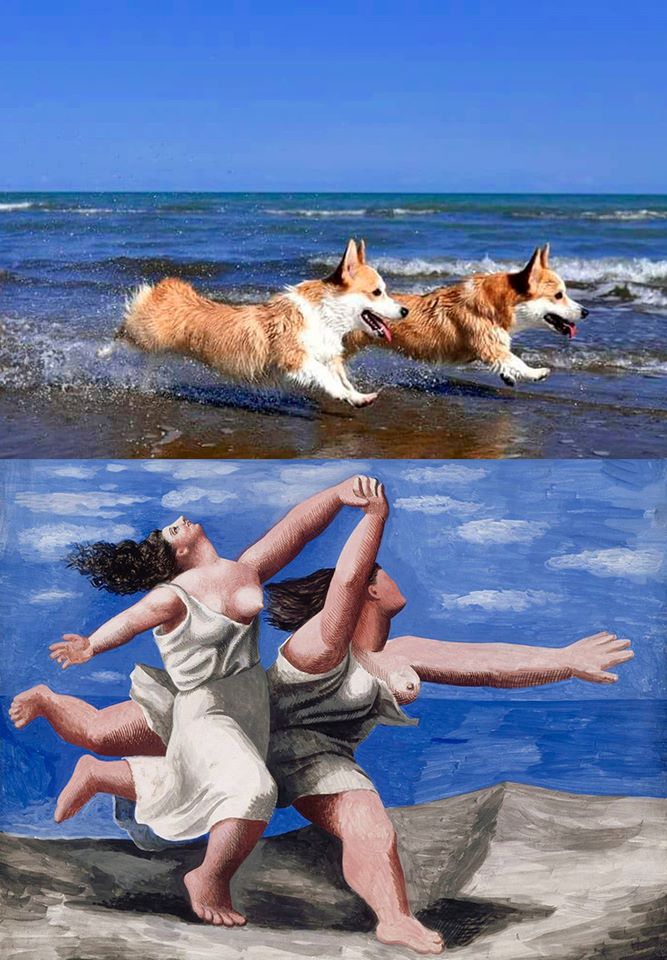
17 April 2020, Friday, 16 °C, sun
Worldwide, the number of infections is almost 2,200,000, of which nearly 150,000 have died. In the USA: over 670,000 infections; in Spain: 185,000; in Italy: nearly 169,000; in France: 147,000; in Germany: 138,000; in Great Britain: nearly 110,000; in Russia: 32,000; in Poland: 8,214; in the Czech Republic: 6,437.
I am working and, as I have many master’s theses to check, it is an uphill battle, and someone is calling me, and someone else is writing, and I am checking something on FB…
Mateusz called and asked me for a text for the publication he is preparing for Poznań’s Art Week festival. He said that the virus has a powerful impact on the entire art world; museums and galleries are closed almost everywhere, fairs, exhibitions and reviews have been cancelled. Everything is upside down. The Irish Museum of Modern Art in Dublin has been converted into a temporary morgue, and a field hospital operates in fair and exhibition halls in Madrid.
However, there are also positive sides to the situation in which we have found ourselves. In response to a recent e-learning question about art during the pandemic, one student wrote that people are now discovering new ways of doing things (also creating new artworks) that they would not normally have come across. So, they see the positive aspects of the entire situation, learn new things and become more creative.
Just like me, my diary and my blog. Or like Wera who will sew masks on my grandmother’s old sewing machine.
As for creativity, I am watching the Quarantine/Isolation group founded on Facebook in Russia. Hundreds of participants take part in it, creating ‘live images’. Thus, an interesting nineteenth-century tradition has returned. People are competing with ingenuity because how do you present the landscape in an apartment? For example, standing in front of an open fridge. Most of these works are kitschy, but they show how much we need art and imagination to survive.
One of my favourite and also post-humanist ‘live images’ relates to Pablo Picasso’s painting Two Women Running on the Beach. The picture shows two white-red dogs galloping by the sea (most likely bitches). The colour convergence of the image and photo is amazing. Both express vitality, freedom and joy of being in nature – everything we are missing so much now.
Some museums, such as The Getty Museum in Los Angeles,8 have come out with similar initiatives to create quarantined live images.
An interesting strategy has been adopted by the Lithuanian artist Paulina Eglė Pukytė, previously active mainly in public space. In the Quarantine Art Challenge/The Art of Aping series, she uses a monkey-shaped mascot, sometimes accompanied by another toy. The artist also reproduces various works of art. For example, Quarantine Art Challenge No. 24 first refers to The Kiss by Auguste Rodin from 1882 and to the corresponding work entitled The Distance (A Kiss with Strings Attached) by Cornelia Parker from 2003. The kissing monkeys in the latter case are wrapped with tape. Moreover, the monkey is depicted as a dead Lenin referencing Kuzma Petrov-Vodkin’s painting from 1924. With silver cellophane on the face, the monkey also explains art to a dead rabbit (of course, in relation to Beuys). I love her works!
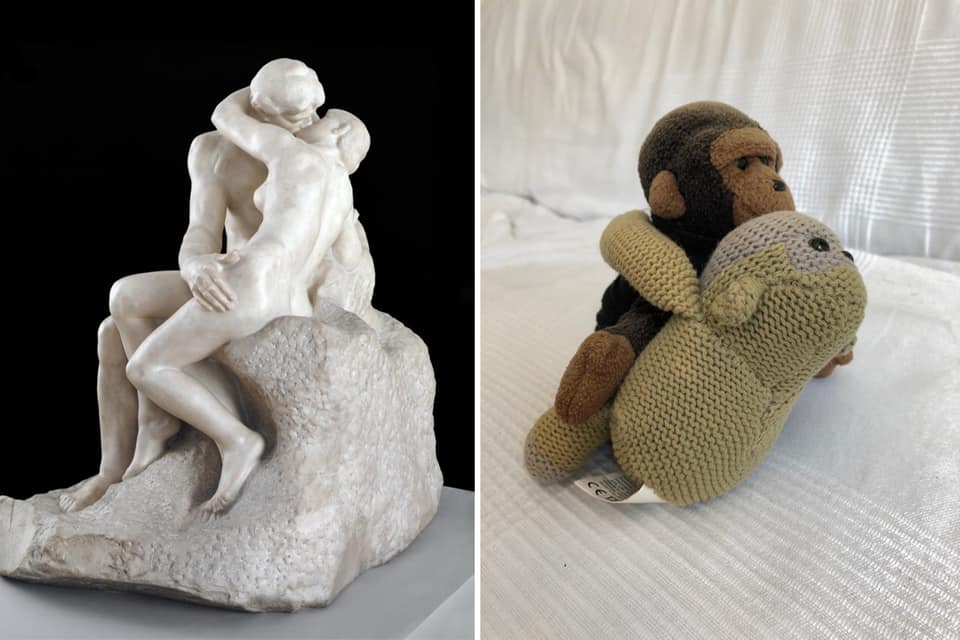
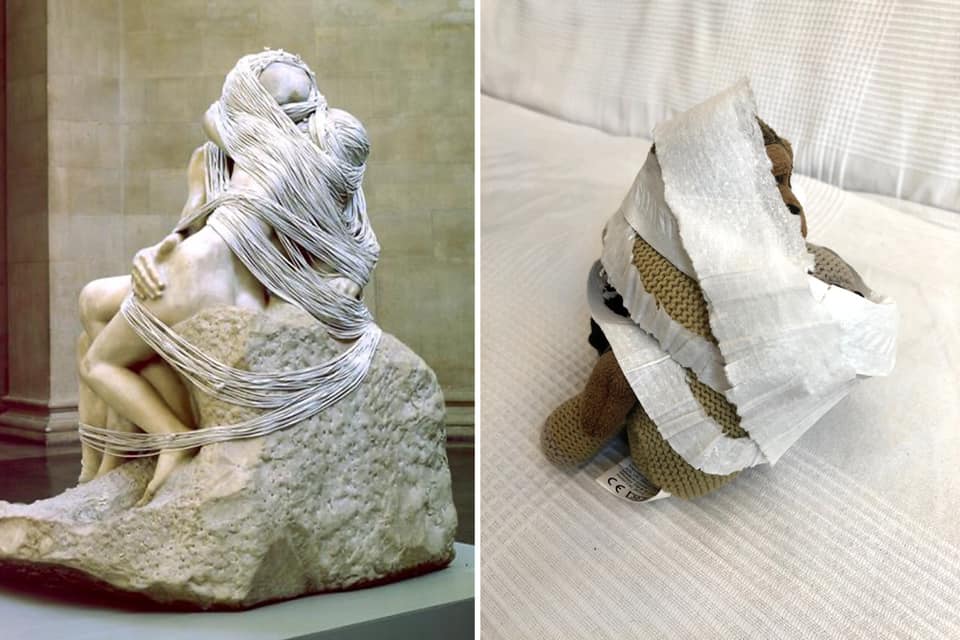
And so, the art of appropriation is flourishing during the pandemic.
Banksy, in turn, published a photo of his bathroom on Instagram two days ago, which he has decorated with characteristic rat figures. And because they integrate with the environment, there is a terrible mess: they have tilted the mirror, unrolled toilet paper and dirtied the toilet seat. Banksy confesses: ‘My wife hates it when I work from home.’

22 April 2020, Wednesday, 16 °C, sun
In Poland, over 10,000 infections, in Europe the situation is stabilising, it is worse in Africa and both Americas.
Meanwhile, we are probably starting to normalise the current situation. Today we had a teleconference of our Scientific Council. In addition to discussing important matters, it was simply good to see each other and chat.
We are increasingly switching to remote work. In this mode, we are planning to hold the defence of diplomas and even enrolment for studies.
In the evening, Staszek and I watched an on-line concert organised by Centrum Kultury Zamek for the benefit of a boy fighting malignant lymphoma.
The musicians howling in front of the cameras, without a professional sound system, were a bit embarrassing.
We were touched by Lao Che’s leader, who sang with his daughters, but they sang better than him. Grabarz played a political protest song and it was a strong point of the programme. Czesław Mozil sang again his wistful song about Jesus the migrant.
During some of the recording, a cat was walking in front of the bass player (this is a permanent part of many online meetings and performances. Renata’s cat was the leader during today’s council meeting).
Siqu (Ania Brachaczek and her partner Ślimak, who is the drummer in Acid Drinkers) played well. However, the philodendron standing in the room looked quite absurd in the context of the music they played.
There was something embarrassing and touching in this concert at the same time. Of course, we donated money.
Today I talked with older Hanka about the fact that switching to an on-line mode without experience with a camera is not easy. All these curatorial tours, online performances, art created in isolation and even online lectures are somehow embarrassing. Someone’s child is running into his or her room, someone else is sitting against a yellow wall, where he or she looks terrible, a cat is entering someone else’s camera frame or you can see a funny philodendron. All in all, it doesn’t matter that much, but when you switch to this mode, you have to suddenly reveal some of your privacy, show a completely different side of yourself. Because when we performed public roles, we would rather not be seen in tracksuits, with children, cats, philodendrons, and most of us drew energy from the direct reaction of the audience. Meanwhile, the latter is replaced by the screen. And everything is mixed up.
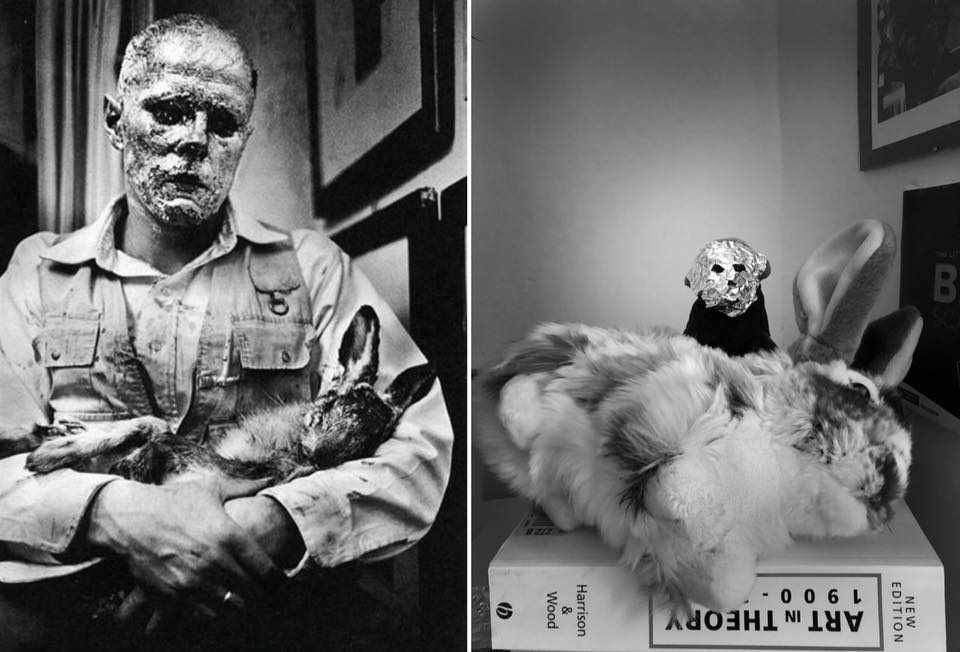
24 April 2020, Friday, 18 °C, sun
I think we are actually getting used to the situation. This is what I conclude from the answers to the e-learning tasks I receive from students. I asked them to watch Iza Chamczyk’s performance and write about their impressions.
Students indicate that this work actually reflects their emotional state at the beginning of the epidemic. Many people write that at the beginning they obsessively checked data on the number of infections. That reality seemed to surpass them. Not only were messages annoying, but also the competitions – who will sew more masks, who will make better bread, who will make more interesting artistic works. They fell onto this treadmill and, on the other hand, the biggest problem for them was the organisation of time because it was still slipping through their fingers.
Several students wrote that they were very afraid for themselves and their loved ones and they were still panicking. Some write that since they stopped checking information on the number of cases, they feel better and are calmer.
Several people indicate that Iza Chamczyk’s work had a therapeutic effect on them, that they felt relief. One student writes that although it was terrible stressful for her to go to the store (and especially the logistics related to putting on a mask, gloves, the disinfection), now that she is about to go out, she recalls Chamczyk’s action and goes out with a smile.
I feel better thanks to yoga and walking in the woods. I have the impression that it is a little easier to mobilise and organise work. I have also stopped panicking that I can’t manage to do everything.
I still have no idea what to write for Mateusz for Art Week. It is impossible to separate art from everyday reality now…

28 April 2020, Monday, 18 °C, sun
In Poland there has been no large increase in infections so far. So far 11,902 infections have been reported.
And the worst news of the day, which has been anticipated by us for a long time: the Pol’And’Rock 2020 festival will take place in the form of a house party.
How I miss these crowds, our fantastic workshop participants, hugs with random people, pointless wandering around this sandy area, visiting loved ones in their villages, singing along with the guitar until morning. The house party is no substitute for this… I’m sad.
30 April 2020, Friday, 16 °C, cloudy
There are already over 3,200,000 infections worldwide, including over 1,000,000 in the USA, almost 240,000 in Spain, over 205,000 in Italy, over 166,000 in France and Germany, over 106,000 in Russia and 12,877 in Poland.
The government announced yesterday that cultural institutions would be opened on 4 May.
Centrum Kultury Zamek in Poznań publishes a statement in which the managers emphasise that they cannot wait for the day when they welcome guests to the centre, but are surprised by the government’s decision to open the institution this Monday: ‘If we were to stick strictly to this date, taking account of the May break, we would have very little time to prepare. The opening of Centrum Kultury Zamek on 4 May seems unreal and dangerous to us. We must first learn about sanitary requirements and adapt to them. The safety of employees and guests is our priority.’
Returning to normal will not happen overnight, especially since the number of infections increases every day. Poznań Art Week will be held online.
Today I received the answer to an outstanding task from a student of our faculty. She writes: ‘Chamczyk’s performance made me realise one more thing. Artists are already implementing their creative activity based on the ongoing pandemic situation. I wonder if the pandemic will cause some breakthrough in art. If so, what will happen?’
This question seems to bother many of us.
I have to give Matusz the text. I have decided to give him fragments of my diary because the current situation, like never before, clearly shows how art intertwines with reality and vice versa. How much art is needed, especially in these difficult times, becoming a moment of fun, respite or therapy. Artists develop imagination, point to unusual solutions, warn and encourage. For example, Catering for the Longest-staying Guests in the Gallery by Leszek Golec and Tatiana Czekalska is still in the Arsenał, they offer mindfulness and tenderness to the world and all living things.
Art can, therefore, actually be a kind of remedy for us.
I hope that artists will develop this tenderness towards the world. And when we actually leave our homes, we will appreciate the importance of direct contact with art.
- https://pasiecznik.wordpress.com/2014/05/01/zwyciestwo-nad-sloncem/ (accessed on 25 May 2020). [↩]
- https://coronavirus.jhu.edu/map.html (accessed on 25 May 2020). [↩]
- https://artmuseum.pl/pl/filmoteka/praca/azorro-grupa-family (accessed on 25 May
,2020). [↩] - J. Dehnel, Ale z naszymi umarłymi, Wydawnictwo Literackie, Kraków 2019, p. 56 (my translation). [↩]
- For more, see https://www.antyradio.pl/Filmy-i-seriale/Seriale/The-Walking-Dead-koronawirus-dotarl-do-szpitala-w-ktorym-Rick-Grimes-obudzil-sie-w-1-odcinku-39674 (accessed on 25 May 2020). [↩]
- https://www.antyradio.pl/News/Nadchodzi-apokalipsa-Satanistyczne-kozly-przejely-miasteczko-w-Walii-WIDEO-40288 (accessed on 25 May 2020). [↩]
- https://plus.gloswielkopolski.pl/filozof-z-uam-o-pandemii-koronawirusa-nie-wiemy-czy-plyniemy-na-titanicu-czy-lecimy-tupolewem/ar/c1-14908008 (accessed on 25 May 2020). [↩]
- https://awesomejelly.com/museums-ask-people-to-recreate-famous-paintings-at-home-receive-hilarious-pics/?fbclid=IwAR1ahnF4eWTfjuvcXFX70HHrEv1dGaeugedB2XXK6-iy1ZQtOGYq3Xy0Nr0 [↩]
